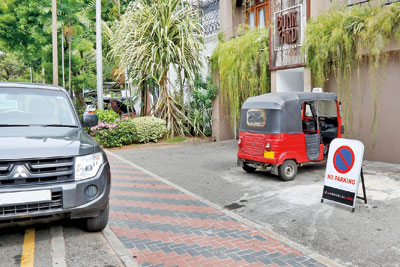News
Dodgy no-parking signs drive motorists round the bend
Illegal, invalid and incomplete “No Parking” signboards are frustrating motorists around the country. Some of these boards give incomplete information, not clearly stating the specific distance and/or time when parking is not allowed. Others are invalid because they do not comply with the standards in the Motor Traffic Signs Regulations gazette. Still others are downright illegal as they have been put up without the approval or knowledge of the relevant authorities.

A signboard close to the Lionel Wendt Theatre. Pix by M.A. Pushpa Kumara
“According to the Motor Traffic Act, the competent authorities to issue permanent no-parking signboards are the Road Development Authority (RDA), the Provincial Road Development Authority and the Local Government Authorities,” said T. Perinpanayagam, a former Deputy Inspector General, Traffic (Retired), and the chief advisor to the government on traffic-related matters.
“These boards should bear the words “By order of … followed by the name of the authority on the reverse of the board. The police have the authority only to put up temporary signboards for cycle races, peraheras, rallies and processions, and these should be removed soon afterwards. These can only be put up by an officer who is an Assistant Superintendent of Police (ASP) or above,” Mr Perinpanayagam said.
“Despite this, you see a number of such boards with a label reading ‘By Order of SSP Traffic” followed by the division, being put up by shops, offices, and other buildings for indefinite periods. This is illegal. “Furthermore, most of these boards advertise a company name below the notice. This makes the board invalid according to Section 224 of the Motor Traffic Act. Only non-profit-making organisations can have their name on the board, and only if it doesn’t distract the motorists’ attention from the board’s purpose,” Mr. Perinpanayagam said.
The Director of Traffic Administration and Road Safety, SP Indika Hapugoda, confirmed there were a number of illegal boards without any mark of authority. “The area police are responsible for checking on these and getting them removed,” he said. Commenting on the boards bearing the label “By order of SSP Traffic …” put up in front of buildings, he said it should be established whether the board had indeed been issued by the SSP. “Some people make the board themselves without the knowledge of the police. This is blatantly illegal and it becomes our responsibility as it bears our name. We then have to look into how it came there and take action.”

An illegal signboard in Havelock Town
SP Hapugoda said if police wished to make a temporary no-parking area permanent they had to bring it up at the area Traffic Committee, which includes the authority in charge of that road. Only the authority had the power to make a temporary order permanent. “According to Section 166, police are allowed to prevent parking even in the absence of a signboard if the officer present believes that parking would cause a roadblock or inconvenience other motorists in some way,” the officer stated.
Incomplete boards also cause problems. Previously, any board that did not contain a panel with a directional arrow and/or specified time periods was considered invalid. A gazette issued in 2015 stated, however, that boards even lacking such advice disallowed parking from such a board up to the next junction in either direction.
SP Hapugoda said that although this was the law, police would only charge people who parked in the area of the board because some junctions could be miles away, making the law impractical to obey. Mr. Perinpanayagam said these problems arose when boards were issued haphazardly and not according to the 1968 Vienna Convention on Road Traffic, which sets out standard traffic rules and to which Sri Lanka is a signatory. “Boards that don’t include the arrow panels are incomplete and confuse motorists,” he declared.
He also said no-parking boards on private roads required approval from the authorities and would be considered illegal without this. “Traffic cones without a no-parking symbol are illegal in all cases,” Mr. Perinpanayagam added. The police may use cones with the symbol but these should be moved as soon as an occasion is over. Many offices, shops, and even three-wheeler stands use the standard cone to reserve parking on public roads. Strict law must be enforced on these. These cones are for the police to close roads or divert traffic,” Mr. Perinpanayagam said.
Kandy roads were peppered with illegal signboards, the Officer in Charge of the Kandy Police Station, Chief Inspector M.W.S. Uvindasiri, said. “Previously, Siddhalepa sponsored boards for the Esala Perahera but we stopped this now as it is illegal,” he said. A police officer at the Matara Police Station said the local authority in the city issued signboards without going through the local Traffic Committee, paying no heed to police advice.
Colombo Municipal Council Commissioner V.K.A. Anura said council workers carried out city checks twice a week and removed illegal boards, charging fines if necessary.

An incomplete signboard in Kirulapone

